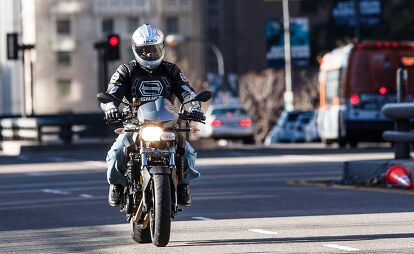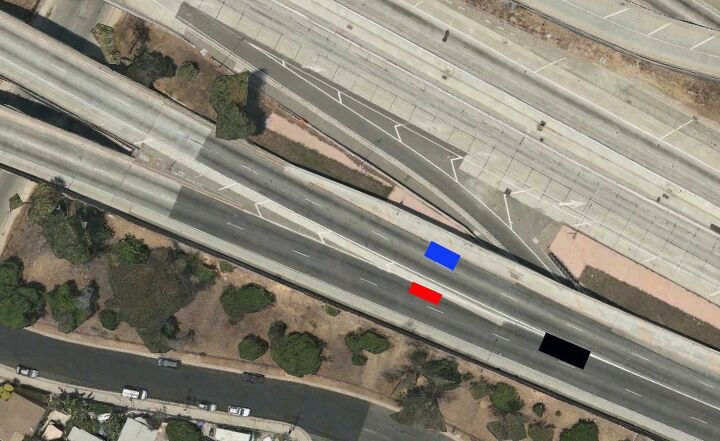Evans Off Camber – Seconds and Inches

Two weeks ago, as I rode to MotoGP Werks to dyno and weigh the Star V Star 950, I had a bit of a close call. Nothing major, really, just one of those things that happens to urban riders from time to time. In these situations, I try to perform a quick personal incident report as soon as possible after the event has passed. As often happens, I found several things that I had done which contributed to the event. I failed to consider a fact that, in this chain of events, led both myself and the driver of the other vehicle to try to occupy the same piece of tarmac at the same time.
Evans Off Camber – Us Versus Them
The event took place on a section of freeway the features a pair of cascading lane merges – the first of which shuffles four lanes down to three by folding the right two lanes into each other shortly after the initial merge. As a result, people are moving left from the soon-to-end right lane into a lane that is at the same time folding together with another pair of lanes. This merge is complicated by the fact that both pairs of lanes curve together at the merge point, placing the traffic in each other’s blind spots.
So, the event played out like this: I’m in the left lane of the pair of lanes merging in from the right as I come up on a Suburban with tinted rear windows. Yes, I’m speeding, but I’m closing in on the Suburban at a reasonable pace. As we approached the merge, I note that the lane on my left appears to be empty. However, just before I begin my lane change, I check my blind spot to make sure that the car I saw previously was in the far lane and not the one I’m moving into. Just prior to my head check, I signaled my intention.
So, certain that the space is clear, I begin my lane change while returning my head to the forward-facing position. In the fraction of a second I had my head turned, the traffic slowing in front of the Suburban has caused the driver to lift off the throttle and begin an unsignaled lane change. Even before my head stops turning, I’m immediately on the brakes, knowing that the lane to my left was already occupied. However, I do have more room in my lane to drift left and create more time as my acceleration relative the Suburban decreases to become deceleration. Ultimately, my front wheel gets about two feet from his bumper before we separate. At this point he sees me in his mirror and gives me a wave of apology.
It was close but not traumatic enough to even raise my pulse rate. Knowing I was partly at fault, I waved an apology to the driver, too. In my post-event analysis, I decided that my biggest mistake was not considering that he could only see me with his side mirrors. Had he been in a car, my high beam would’ve been shining in his rear-view mirror, (hopefully) making him aware of my presence. Yes, going slower would have also prevented this incident, and that’s the obvious mistake I made. The lesser one of not considering the SUV’s enlarged blind spot is the one that requires the implementation of new strategies. So, that’s the one I’ve been focusing on since the incident.
I can imagine some readers thinking that this is all fine and dandy, but what about the times that the other person is completely in the wrong? Even then, if you’re willing to look at yourself honestly, you can find small ways that you contributed to the situation.
For example, this past summer, I was riding home after dropping my daughter off at her ballet class. (An aside: if you ever want people to look at you like you have two heads, show up at a ballet studio with your daughter and you carrying riding gear.) Riding home alone, I was in the left lane of a six-lane, divided urban thoroughfare. A car a half-block ahead of me pulled out into the right lane and accelerates up to speed ahead of the traffic I’m pacing in all three lanes. Suddenly, without warning, the car whips across the middle lane and begins to slow. As above, I employ the same technique of braking and pulling to the left of the lane. Only in this instance, the time is much more compressed. I’m in full-on maximum braking, and as I get my wheels within inches of the median’s curb, I feel the rear ABS begin to pulse. Shortly after that, the front does the same. To make matters worse, the median is lined with trees at about 30 foot intervals. I had nothing else to do but maintain my line, avoiding the curb, while watching the car’s fender get closer – until the bumper passes an inch or so in front of me.
I’d like to say that I brushed this off and went on to learn my latest motorcycling lesson, but that had to wait. Instead, the unsuspecting driver had reopened an old wound, in which a friend of mine was forced off the road where he crashed and slid head-first into a 4 x 4 in. post – about the size of the trees in the median. This poor woman, who had almost taken me out, was on the receiving end of the years of stored rage over the loss of my friend which was compounded by my enormous adrenaline rush. To make matters worse – for both of us – she clearly didn’t know that she had almost hit me. Just like my friend’s killer never knew – as opined by the witnesses of the accident – what he had done as he continued obliviously down the road.
What was my role in this incident? Simple. As she pulled out into traffic, I looked at her lane positioning, noted her rate of acceleration, and assessed her with a zero risk rating. I had no alternate plan in place when she pulled her stunt. Was she just an asshole driver? Was she distracted by the crying infant in the carseat behind her? (Yeah, there was one.) Or was she just an oblivious idiot? It doesn’t matter. I failed to account for her in my immediate plan of action, and that responsibility lies squarely on my shoulders.
Motorcycling can be a game of inches and seconds – with the highest of stakes. All my riding buddies have stories about how they narrowly escaped disaster. Others, unfortunately, can tell of how they came up short. Sadly, a dear friend can’t do anything, anymore. Although it’s impossible to prepare for every scenario, it’s far too easy for us, as riders, to direct the blame completely at the drivers of the vehicles involved. That’s putting our lives in their hands. Instead, we have to look for the lesson in every unexpected riding situation and then utilize what we’ve learned.
Using your head is the most important skill you can develop on a motorcycle. Apply it liberally while riding.

Like most of the best happenings in his life, Evans stumbled into his motojournalism career. While on his way to a planned life in academia, he applied for a job at a motorcycle magazine, thinking he’d get the opportunity to write some freelance articles. Instead, he was offered a full-time job in which he discovered he could actually get paid to ride other people’s motorcycles – and he’s never looked back. Over the 25 years he’s been in the motorcycle industry, Evans has written two books, 101 Sportbike Performance Projects and How to Modify Your Metric Cruiser, and has ridden just about every production motorcycle manufactured. Evans has a deep love of motorcycles and believes they are a force for good in the world.
More by Evans Brasfield



































Comments
Join the conversation
yep.
So your friend is dead and according to you, it's his own damned fault.
Great way to blame the victim.